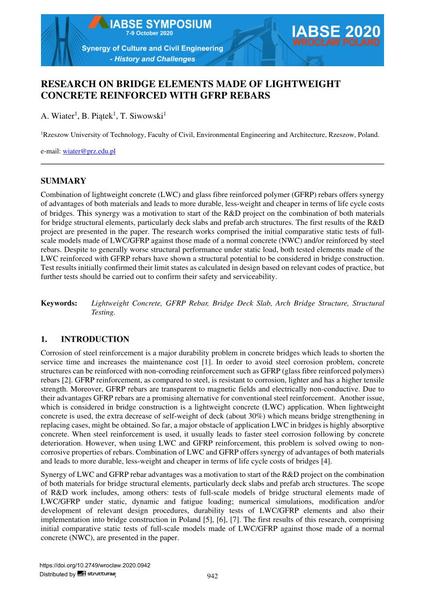Research on Bridge Elements Made of Lightweight Concrete Reinforced with GFRP Rebars

|
|
|||||||||||
Bibliografische Angaben
| Autor(en): |
A. Wiater
B. Piątek T. Siwowski |
||||
|---|---|---|---|---|---|
| Medium: | Tagungsbeitrag | ||||
| Sprache(n): | Englisch | ||||
| Tagung: | IABSE Symposium: Synergy of Culture and Civil Engineering – History and Challenges, Wrocław, Poland, 7-9 October 2020 | ||||
| Veröffentlicht in: | IABSE Symposium Wroclaw 2020 | ||||
|
|||||
| Seite(n): | 942-949 | ||||
| Anzahl der Seiten (im PDF): | 8 | ||||
| Jahr: | 2020 | ||||
| DOI: | 10.2749/wroclaw.2020.0942 | ||||
| Abstrakt: |
Combination of lightweight concrete (LWC) and glass fibre reinforced polymer (GFRP) rebars offers synergy of advantages of both materials and leads to more durable, less-weight and cheaper in terms of life cycle costs of bridges. This synergy was a motivation to start of the R&D project on the combination of both materials for bridge structural elements, particularly deck slabs and prefab arch structures. The first results of the R&D project are presented in the paper. The research works comprised the initial comparative static tests of full- scale models made of LWC/GFRP against those made of a normal concrete (NWC) and/or reinforced by steel rebars. Despite to generally worse structural performance under static load, both tested elements made of the LWC reinforced with GFRP rebars have shown a structural potential to be considered in bridge construction. Test results initially confirmed their limit states as calculated in design based on relevant codes of practice, but further tests should be carried out to confirm their safety and serviceability. |
||||
